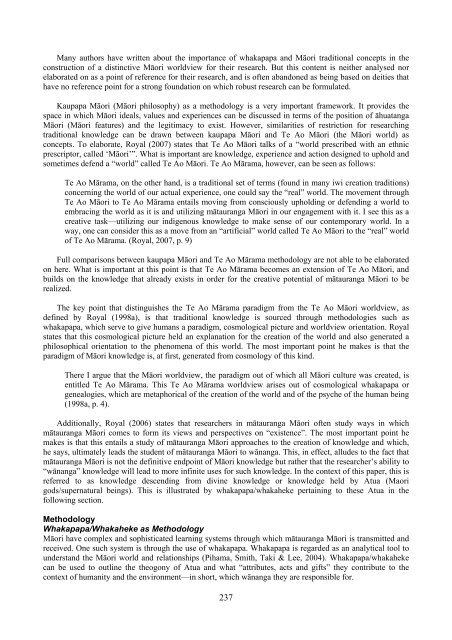traditional knowledge conference 2008 te tatau pounamu
traditional knowledge conference 2008 te tatau pounamu
traditional knowledge conference 2008 te tatau pounamu
You also want an ePaper? Increase the reach of your titles
YUMPU automatically turns print PDFs into web optimized ePapers that Google loves.
Many authors have writ<strong>te</strong>n about the importance of whakapapa and Māori <strong>traditional</strong> concepts in theconstruction of a distinctive Māori worldview for their research. But this con<strong>te</strong>nt is neither analysed norelabora<strong>te</strong>d on as a point of reference for their research, and is of<strong>te</strong>n abandoned as being based on deities thathave no reference point for a strong foundation on which robust research can be formula<strong>te</strong>d.Kaupapa Māori (Māori philosophy) as a methodology is a very important framework. It provides thespace in which Māori ideals, values and experiences can be discussed in <strong>te</strong>rms of the position of āhuatangaMāori (Māori features) and the legitimacy to exist. However, similarities of restriction for researching<strong>traditional</strong> <strong>knowledge</strong> can be drawn between kaupapa Māori and Te Ao Māori (the Māori world) asconcepts. To elabora<strong>te</strong>, Royal (2007) sta<strong>te</strong>s that Te Ao Māori talks of a “world prescribed with an ethnicprescriptor, called ‘Māori’”. What is important are <strong>knowledge</strong>, experience and action designed to uphold andsometimes defend a “world” called Te Ao Māori. Te Ao Mārama, however, can be seen as follows:Te Ao Mārama, on the other hand, is a <strong>traditional</strong> set of <strong>te</strong>rms (found in many iwi creation traditions)concerning the world of our actual experience, one could say the “real” world. The movement throughTe Ao Māori to Te Ao Mārama entails moving from consciously upholding or defending a world toembracing the world as it is and utilizing mātauranga Māori in our engagement with it. I see this as acreative task—utilizing our indigenous <strong>knowledge</strong> to make sense of our con<strong>te</strong>mporary world. In away, one can consider this as a move from an “artificial” world called Te Ao Māori to the “real” worldof Te Ao Mārama. (Royal, 2007, p. 9)Full comparisons between kaupapa Māori and Te Ao Mārama methodology are not able to be elabora<strong>te</strong>don here. What is important at this point is that Te Ao Mārama becomes an ex<strong>te</strong>nsion of Te Ao Māori, andbuilds on the <strong>knowledge</strong> that already exists in order for the creative po<strong>te</strong>ntial of mātauranga Māori to berealized.The key point that distinguishes the Te Ao Mārama paradigm from the Te Ao Māori worldview, asdefined by Royal (1998a), is that <strong>traditional</strong> <strong>knowledge</strong> is sourced through methodologies such aswhakapapa, which serve to give humans a paradigm, cosmological picture and worldview orientation. Royalsta<strong>te</strong>s that this cosmological picture held an explanation for the creation of the world and also genera<strong>te</strong>d aphilosophical orientation to the phenomena of this world. The most important point he makes is that theparadigm of Māori <strong>knowledge</strong> is, at first, genera<strong>te</strong>d from cosmology of this kind.There I argue that the Māori worldview, the paradigm out of which all Māori culture was crea<strong>te</strong>d, isentitled Te Ao Mārama. This Te Ao Mārama worldview arises out of cosmological whakapapa orgenealogies, which are metaphorical of the creation of the world and of the psyche of the human being(1998a, p. 4).Additionally, Royal (2006) sta<strong>te</strong>s that researchers in mātauranga Māori of<strong>te</strong>n study ways in whichmātauranga Māori comes to form its views and perspectives on “exis<strong>te</strong>nce”. The most important point hemakes is that this entails a study of mātauranga Māori approaches to the creation of <strong>knowledge</strong> and which,he says, ultima<strong>te</strong>ly leads the student of mātauranga Māori to wānanga. This, in effect, alludes to the fact thatmātauranga Māori is not the definitive endpoint of Māori <strong>knowledge</strong> but rather that the researcher’s ability to“wānanga” <strong>knowledge</strong> will lead to more infini<strong>te</strong> uses for such <strong>knowledge</strong>. In the con<strong>te</strong>xt of this paper, this isreferred to as <strong>knowledge</strong> descending from divine <strong>knowledge</strong> or <strong>knowledge</strong> held by Atua (Maorigods/supernatural beings). This is illustra<strong>te</strong>d by whakapapa/whakaheke pertaining to these Atua in thefollowing section.MethodologyWhakapapa/Whakaheke as MethodologyMāori have complex and sophistica<strong>te</strong>d learning sys<strong>te</strong>ms through which mātauranga Māori is transmit<strong>te</strong>d andreceived. One such sys<strong>te</strong>m is through the use of whakapapa. Whakapapa is regarded as an analytical tool tounderstand the Māori world and relationships (Pihama, Smith, Taki & Lee, 2004). Whakapapa/whakahekecan be used to outline the theogony of Atua and what “attribu<strong>te</strong>s, acts and gifts” they contribu<strong>te</strong> to thecon<strong>te</strong>xt of humanity and the environment—in short, which wānanga they are responsible for.237
















